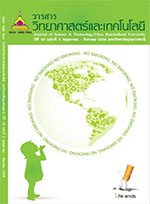วานิลลา: ศักยภาพการขยายพันธุ์โดยการเพาะเลี้ยงเนื้อเยื่อ
Main Article Content
บทคัดย่อ
วานิลลาเป็นกล้วยไม้ที่ฝักหรือผลเป็นสารแต่งกลิ่นในอาหาร เครื่องดื่ม เครื่องสำอางและน้ำหอม สายพันธุ์ที่นิยมปลูกเพื่อใช้ผลิตฝักวานิลลาในทางการค้า คือ Vanilla planifolia โดยทั่วไปการขยายพันธุ์วานิลลาทำโดยการปักชำกิ่งที่ได้จากเถาแก่ แต่อย่างไรก็ตามการขยายพันธุ์จากกิ่งชำได้จำนวนน้อยใช้ระยะเวลาการขยายพันธุ์นาน และปัญหาที่สาคัญคือ ความเสี่ยงที่กิ่งชำจะมีการปนเปื้อนเชื้อโรค เช่น ไวรัส เชื้อรา และ แบคทีเรีย บทความนี้จึงได้เรียบเรียงเทคนิคการเพาะเลี้ยงเนื้อเยื่อวานิลลาเพื่อเป็นทางเลือกในการเพิ่มจำนวนต้นวานิลลาที่ปลอดโรคอย่างมีศักยภาพ การเพิ่มจำนวนต้นวานิลลาโดยใช้เทคนิคเพาะเลี้ยงเนื้อเยื่อมีอยู่สองแนวทาง คือ การเพาะเมล็ดในสภาพปลอดเชื้อ และการเพาะเลี้ยงชิ้นส่วนเนื้อเยื่อเจริญ ซึ่งการเพาะเมล็ดในสภาพปลอดเชื้อ ควรใช้ฝักที่มีอายุ 6-7 เดือน โดยมีเทคนิคที่สำคัญ คือ การล้างไขมันที่เคลือบเมล็ดออกด้วยเอทธานอล 95 เปอร์เซ็นต์ นำเมล็ดไปเพาะในอาหารสังเคราะห์สูตร MS ที่เติมกรดอะมิโน tryptone และสารควบคุมการเจริญเติบโตพืชในกลุ่มไซโตไคนิน เช่น BAP และ kinetin อุณหภูมิที่เหมาะสมในการเพาะเมล็ด คือ 32oซ ในที่มืด ส่วนการเพาะเลี้ยงเนื้อเยื่อชิ้นส่วนเนื้อเยื่อเจริญ มี 3 ขั้นตอน คือ การชักนำชิ้นส่วนให้เกิดยอดใหม่ การเพิ่มจำนวนยอด และการพัฒนายอดให้เป็นต้นอ่อน โดยนำชิ้นส่วนปลายยอด ข้อ และตาข้าง มาเลี้ยงในอาหารสังเคราะห์ที่มีการเติมสารในกลุ่มไซโตไคนิน เช่น BAP kinetin zeatin และ TDZ หรือสารตั้งต้นของไซโตไคนิน เช่น adenine sulfate หรือสารอินทรีย์ที่ได้จากพืช เช่น น้ามะพร้าว สารเหล่านี้จะส่งเสริมให้ชิ้นส่วนมีการแบ่งเซลล์ ชักนำให้เกิดยอดใหม่และเพิ่มจำนวนยอดให้มากขึ้น ยอดวานิลลาที่เกิดขึ้นสามารถเกิดรากได้ง่ายในอาหารสังเคราะห์ที่มีหรือไม่มีการเติมสารในกลุ่มออกซิน ต้นอ่อนวานิลลามีอัตราการรอดชีวิต 85-95 เปอร์เซ็นต์ เมื่อนำออกปลูกในสภาพธรรมชาติ
Vanilla: The Potential of Micro-propagation
Vanilla is an orchid plant and the pod (fruit) is commercially used to make vanilla flavoring in foods, drinks, cosmetics, and perfume. The main species cultured for pod production is Vanilla planifolia. Vanilla is propagated by stem cutting from nature vines, but this method produces only limited cutting materials and takes a long time. Moreover, the process of stem cutting poses a high risk of infection from many pathogens, including viruses, fungi, and bacteria. This article describes tissue culture techniques as an alternative propagation method having potential to produce disease-free vanilla in quantity. There are two approaches in micro-propagation techniques; in vitro seed culture in which seeds should be taken from 6-7 month old pods and washed in 95% ethanol to eliminate lipid coated on the seed surface. Seeds germination is done in Murashige and Skoog (MS) media supplemented with amino acid (tryptone) and cytokinin (BAP and kinetin) with a condition of 32oC in darkness: in vitro tissue culture includes 3 steps; the shoot induction, shoot proliferation, and plantlets formation. The explants (shoot tip, node, and axillary bud) are cultured in media supplemented with cytokinin (BAP, kinetin, zeatin, and TDZ), or cyotokinin precursor (adenine sulfate), or organic substances, such as coconut water. These substances promote cell division, induce new shoots, and enhance shoot proliferation. Each shoot is well rooted on medium with or without auxin. The survival rate of plantlets is 85-95 % after planting in natural conditions.
Article Details
บทความที่ได้รับการตีพิมพ์เป็นลิขสิทธิ์ของ วารสารวิทยาศาสตร์และเทคโนโลยี มหาวิทยาลัยอุบลราชธานี
ข้อความที่ปรากฏในบทความแต่ละเรื่องในวารสารวิชาการเล่มนี้เป็นความคิดเห็นส่วนตัวของผู้เขียนแต่ละท่านไม่เกี่ยวข้องกับมหาวิทยาลัยอุบลราชธานี และคณาจารย์ท่านอื่นๆในมหาวิทยาลัยฯ แต่อย่างใด ความรับผิดชอบองค์ประกอบทั้งหมดของบทความแต่ละเรื่องเป็นของผู้เขียนแต่ละท่าน หากมีความผิดพลาดใดๆ ผู้เขียนแต่ละท่านจะรับผิดชอบบทความของตนเองแต่ผู้เดียว


